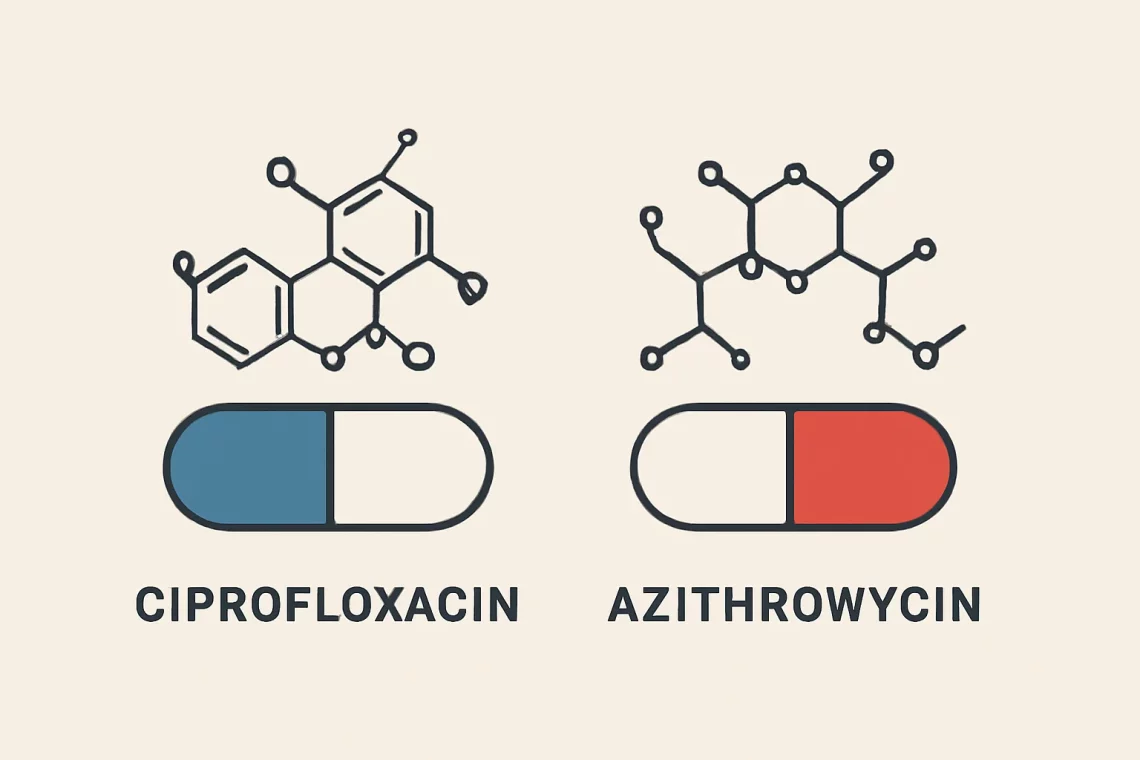-
Azithromycin vs Clindamycin: Key Differences and Uses Explained
Azithromycin and clindamycin are two widely used antibiotics that play a crucial role in treating various bacterial infections. Though they belong to different classes of antibiotics and have distinct mechanisms of action, both are effective in their respective applications. Understanding the differences and similarities between these two medications is essential for healthcare professionals and patients alike. This knowledge can help in selecting the right antibiotic based on the type of infection, the patient’s medical history, and potential drug interactions. Antibiotics like azithromycin and clindamycin work by inhibiting bacterial growth, but they do so in different ways. Azithromycin is a macrolide antibiotic, while clindamycin belongs to the lincosamide class. Each antibiotic…
-
Clindamycin vs Azithromycin: Which Antibiotic Is Right for You?
Clindamycin and azithromycin are two antibiotics that belong to different classes and are often prescribed to treat various bacterial infections. Both medications are effective against specific pathogens but have distinct mechanisms of action and side effect profiles. Understanding the differences between these two antibiotics is essential for both healthcare professionals and patients. Clindamycin is a lincosamide antibiotic that primarily inhibits bacterial protein synthesis, making it effective against anaerobic bacteria and certain Gram-positive organisms. It is often used for skin and soft tissue infections, as well as respiratory tract infections. Azithromycin, on the other hand, is a macrolide antibiotic that also inhibits protein synthesis but acts on a broader spectrum of…
-
Ciprofloxacin vs Azithromycin: Comparing Antibiotics for Infections
Ciprofloxacin and Azithromycin are two widely used antibiotics that belong to different classes of antimicrobial agents. Each drug has its unique mechanism of action, spectrum of activity, and clinical applications. Understanding the differences and similarities between these two medications is crucial for both healthcare professionals and patients alike. Ciprofloxacin, a fluoroquinolone antibiotic, is known for its broad-spectrum efficacy against a variety of bacterial infections. It works by inhibiting bacterial DNA gyrase and topoisomerase IV, enzymes that are essential for bacterial DNA replication, transcription, and repair. This action leads to the death of susceptible bacteria. Ciprofloxacin is often prescribed for respiratory, urinary tract, and skin infections, as well as specific gastrointestinal…
-
Doxycycline vs Azithromycin: Which Antibiotic Is Right for You?
Doxycycline and Azithromycin are two widely used antibiotics that play significant roles in the treatment of various bacterial infections. Both medications belong to different classes and have unique mechanisms of action, which influence their effectiveness against specific types of bacteria. Understanding the differences and similarities between these two antibiotics can be crucial for healthcare professionals when prescribing treatment options and for patients seeking to understand their medications better. Doxycycline, a tetracycline antibiotic, is known for its broad-spectrum activity against various gram-positive and gram-negative bacteria. It is commonly used to treat infections such as pneumonia, acne, and certain sexually transmitted infections. Azithromycin, on the other hand, is a macrolide antibiotic that…
-
Azithromycin vs Levaquin: Key Differences and Uses Explained
Azithromycin and Levaquin are two widely used antibiotics that play a significant role in treating bacterial infections. The medical community often relies on these medications for their effectiveness against various pathogens. However, their mechanisms of action, spectrum of activity, side effects, and indications differ substantially. Understanding these differences is crucial for both healthcare professionals and patients, as the choice of antibiotic can greatly influence treatment outcomes. Both Azithromycin and Levaquin have unique characteristics that make them suitable for specific conditions. Azithromycin, a macrolide antibiotic, is known for its broad spectrum of activity, particularly against respiratory tract infections and certain sexually transmitted infections. On the other hand, Levaquin, a fluoroquinolone, is…
-
Azithromycin vs Erythromycin: Key Differences and Uses Explained
Azithromycin and erythromycin are two widely used antibiotics that belong to the macrolide class of medications. They are both effective in treating various bacterial infections by inhibiting bacterial protein synthesis, which ultimately leads to the death of the bacteria. Both drugs are commonly prescribed for respiratory tract infections, skin infections, and certain sexually transmitted infections, among others. Despite their similarities, there are significant differences between the two that can influence a physician’s choice of treatment. In clinical practice, understanding these differences is essential for selecting the appropriate antibiotic that will effectively target the infection while minimizing potential side effects. Factors such as bacterial resistance, patient tolerance, and specific infection types…
-
Azithromycin vs Doxycycline: Which Antibiotic Is Right for You?
-
Azithromycin vs Biaxin: Key Differences and Similarities Explained
Azithromycin and Biaxin are two widely recognized antibiotics that play crucial roles in the treatment of various bacterial infections. Both medications are part of the macrolide class of antibiotics, which are known for their effectiveness in combating a range of pathogens. Azithromycin is often praised for its broad spectrum of activity and convenient dosing regimen, while Biaxin, or clarithromycin, is noted for its potency and effectiveness in treating specific infections. Understanding the differences, uses, and potential side effects of these two medications is essential for both healthcare professionals and patients alike. As antibiotic resistance continues to rise, the selection of the appropriate antibiotic becomes increasingly important. This not only helps…
-
Azithromycin vs Augmentin: Key Differences and Uses Explained
In recent years, the landscape of medicine has evolved significantly, particularly in the realm of antibiotics. Among the many bacterial infections that affect millions worldwide, the choice of antibiotic can be critical. Two commonly prescribed antibiotics are Azithromycin and Augmentin. Each of these medications has its own unique properties, uses, and mechanisms of action, leading healthcare professionals to make informed decisions when prescribing them. Understanding the differences between these two antibiotics is essential for both patients and practitioners. Factors such as the type of infection, bacterial resistance, and patient history can influence which antibiotic will be most effective. Furthermore, the rise of antibiotic resistance has made it increasingly important to…
-
Azithromycin vs Cipro: Understanding Their Differences and Uses
The world of antibiotics is vast and complex, with many options available to treat various bacterial infections. Two commonly prescribed antibiotics, Azithromycin and Ciprofloxacin, represent distinct classes of medications that serve specific purposes in fighting infections. Both drugs have unique mechanisms of action, side effects, and spectrum of activity, making them suitable for different types of bacterial pathogens. Azithromycin, a macrolide antibiotic, is often favored for its ability to treat respiratory infections, skin infections, and some sexually transmitted diseases. Its convenient dosing schedule and relatively mild side effect profile make it a popular choice among healthcare providers. On the other hand, Ciprofloxacin, a fluoroquinolone, is known for its broad-spectrum activity…







































